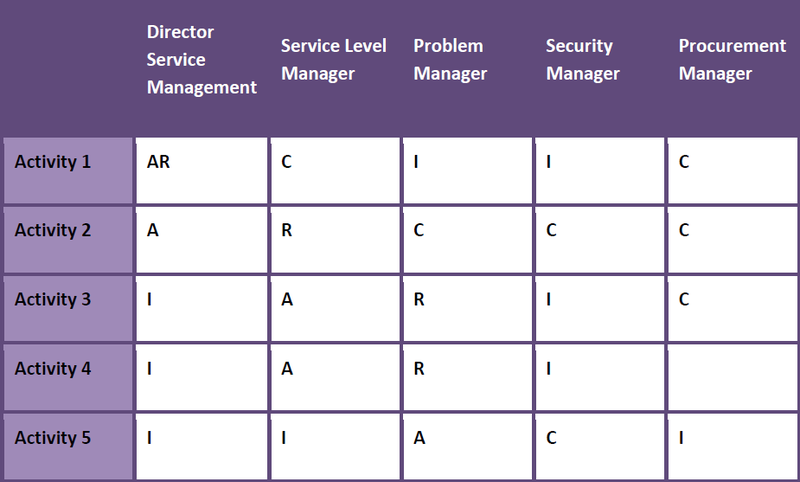Effective role assignment through the RACI matrix (Updated)
 Have you often come across such a phenomenon as irrational distribution of duties? How many times did you have to watch how one person "master of all trades" performs work for five? And the so-called “specialist who does not understand what” is familiar? Such options, as well as similar ones, were often seen earlier in the domestic realities. Many people have to observe this “scoop”, and what is worse, to feel on their personal skin and in many government agencies today.
Have you often come across such a phenomenon as irrational distribution of duties? How many times did you have to watch how one person "master of all trades" performs work for five? And the so-called “specialist who does not understand what” is familiar? Such options, as well as similar ones, were often seen earlier in the domestic realities. Many people have to observe this “scoop”, and what is worse, to feel on their personal skin and in many government agencies today.Such clever phrases as “separation of powers” are often spoken about. But does everyone know how to put it into practice, and who can really use it? Looking carefully, we conclude that this phenomenon occurs by and large, in companies in the private sector, especially those who work with a foreign client.
It is because of the “hillock” that a curious abbreviation called RACI came to us. In this case, often in front of it you can observe all sorts of intelligence a la "matrix" or "model". What it is and what it is eaten with, I will try to explain to the reader further. It is possible that someone is already lucky to work in teams, where everyone knows their duties and area of responsibility - you can only be happy for such people. At the same time, I personally believe that not everyone has everything perfect in the sphere of separation of powers. For such people, this article may be useful.
')
So, what is the RACI matrix? This abbreviation is divided into four specific roles:
- Responsible (marked on the matrix with the letter R ) - directly responsible for the work
- Accountable ( A ) - accountable, such a role can take only one person on one task
- Consulted ( C ) - one employee or group that is consulted about the task and whose opinions should be taken into account
- Informed ( I ) - employees notified of a specific task.
Also, there are two extended versions of the model.
RACI-VS , 2 roles are added here:
- Verifies ( V ) - one employee or group who checks the compliance of the result of the task with the previously agreed criteria
- Signs off ( S ) - approves the delivery of the product to the customer (task performance). This role can be combined with an accountable role.
When using the RASCI model variant , one new role appears:
Supportive ( S ) - provides additional resources for doing work, such as support for product implementation, for example.
On the one hand - “many letters” and nothing is clear. On the other hand, in order to make it clearer, I want to show by example how the RACI matrix itself looks like.

You do not need to be a “cap” to understand that the table header displays a list of functional roles responsible for a particular task or participating directly in the decision making. Items “Activity 1-5” are the actual functions that fall on the shoulders of the above roles.
In order to understand the principle on which such a table should be drawn, as well as how to use it in practice (in real projects), it is recommended to pay due attention to the following procedure when building a matrix:
- We determine the list of required activities / processes in the task (project)
- Define and indicate functional roles (people who are interested or who are in a particular way concerned with this task)
- We gather a rally and assign RACI codes (actually letters) to specific roles, directly delineating responsibility
- Determine the inconsistencies (for example, too many responsible or lack thereof)
- We describe the table and collect reviews
- We control the execution of assigned roles
I admit that it will not be easy for someone to associate Latin letters with the functions that are implied by them. However, I would not advise using their Russian versions - it is likely that there will be confusion, it will become even more difficult to figure out what's what.
And finally, after we finished the development of the RACI model, it would not hurt to analyze the results.
By functional roles, we can analyze, answering such questions:
- A lot of "A" - are the duties assigned correctly? Are there bottlenecks?
- A lot of “R” - aren't we having a lot of responsibility for one role?
- No empty cells in the table - should this role really be involved in so many tasks?
Also, do not forget to analyze the activities performed:
- More than one "A" - only one role should be accountable
- Absence of "A" - you need to find accountable
- More than one “R” or lack thereof - someone must be responsible, but we don’t need the responsibility to be widely distributed - there is a risk that the task will not be completed
- Many “C” - should we consult with many roles and will it be effective?
- Absence of “C” and “I” - are our communications properly established?
I would like to dwell on this in order not to make the reader bored. How adequate is such a distribution of functions, exactly how and whether to use such a model is to judge you. Whether it will earn in post-Soviet realities is a moot point. However, working with a foreign customer, the RACI matrix will be not only not superfluous, but will also give a clear understanding to everyone about the activities taking place in the project and the people who carry them out. And the customer, as is known, for the most part, wants to clearly know who and for what is responsible in the task set by him.
I would also like to mention that the RACI matrix is by no means a tool for determining a scapegoat, if only because people who agreed to spend time on its compilation should understand its purpose and purpose a priori.
PS It would be interesting in the comments to hear the views of readers about the possibility of using such a means of distribution of functions, as well as to share personal experience - who has it.
UPD. At the request of the user Sibarit, I will try to give a quick hand an example of using the model on a specific task.
Suppose we have an airline that is going to introduce an online check-in system on its website. The global activities needed to perform in the context of the task will be approximately as follows: gathering system requirements; solution design; direct development of a solution (development); implementation; actually - the “production” stage; solution optimization.
Further, we define the list of functional roles, in this task the following options are possible: internal service provider (airline's IT department) or external service provider in the absence of the first; ISP - hosting company for the airline's website; airline business unit (representing the interests of the customer); financial unit (accounting); service manager (depending on the size of the organization, may be part of the internal IT department); development team (depending on the size of the organization, may be part of the internal IT department).
Let's try to place the RACI codes according to the roles and activities performed by them (it is clear that this process takes place with the participation of all parties).

Thus, the roles and functions in this task will be distributed. At once I want to note that in this and any other project, the matrix options may be different, depending on the specific needs of different companies. I am not going to, after such an example, readers will have a more complete picture of the possibilities of using the RACI matrix.
Source: https://habr.com/ru/post/145553/
All Articles